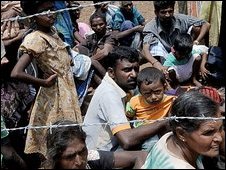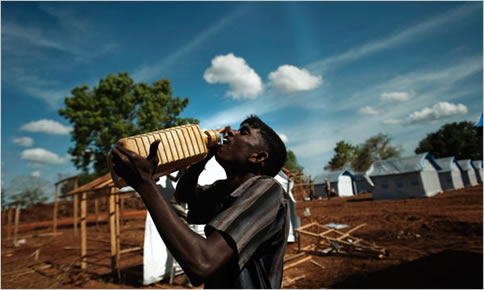 More than two months later, Mr. Theventhran, a 56-year-old Tamil civil servant, finds himself once again a captive, this time of the people who freed him from the Tigers’ grip.
More than two months later, Mr. Theventhran, a 56-year-old Tamil civil servant, finds himself once again a captive, this time of the people who freed him from the Tigers’ grip.Ilankai Tamil Sangam
Association of Tamils of Sri Lanka in the USA
Published by Sangam.org
by Lydia Polgreen, The New York Times, July 12, 2009
|
Indeed, the murky status of the people held here in what many describe as internment camps is emblematic of the conundrum at the heart of Sri Lanka’s civil war. The Tamil Tigers so thoroughly insinuated themselves into Tamil communities, particularly here in the Tamil Tigers’ former stronghold in the north, that in the government’s eyes the two have become virtually synonymous. |
CHEDDIKULAM, Sri Lanka — When the piercing whistle and sharp thuds of artillery shells grew faint, S. Theventhran dashed to safety. After days of cowering in a narrow, open trench on a strip of beach in the northeastern corner of Sri Lanka, he was cheered by the sight of Sri Lankan Army soldiers helping wounded and terrified survivors of the last stand of the Tamil Tiger rebels, who had held nearly 300,000 Tamil civilians hostage.
 More than two months later, Mr. Theventhran, a 56-year-old Tamil civil servant, finds himself once again a captive, this time of the people who freed him from the Tigers’ grip.
More than two months later, Mr. Theventhran, a 56-year-old Tamil civil servant, finds himself once again a captive, this time of the people who freed him from the Tigers’ grip.
“We were liberated,” he said in an interview at one of the sprawling, closed camps set up here to house those displaced in the war against the rebel group, known as the Liberation Tigers of Tamil Eelam. “Now we are prisoners again. I lost everything in this war. The Tigers killed my son. I lost my property. Now I have lost my freedom, too.”
Hundreds of thousands of Tamils remain locked in camps almost entirely off limits to journalists, human rights investigators and political leaders. The Sri Lankan government says that the people in the camps are a security risk because Tamil Tiger fighters are hiding among them.
But diplomats, analysts, aid workers and many Sri Lankans worry that the historic chance to finally bring to a close one of the world’s most enduring ethnic conflicts is slipping away, as the government curtails the rights of Tamil civilians in its efforts to stamp out the last remnants of the Tigers.
 |
| A man drank water as he helped to construct temporary structures for Tamil refugees near Vavuniya, Sri Lanka. |
“The government told these people it would look after them,” said Veerasingham Anandasangaree, a prominent Tamil politician who has been a staunch supporter of the government’s fight against the Tamil Tigers. “But instead they have locked them up like animals with no date certain of when they will be released. This is simply asking for another conflict later on down the road.”
The Sri Lankan government has portrayed its final battle against the 26-year insurgency by the Tamil Tigers, which ended in late May with the killing the group’s leader, Velupillai Prabhakaran, as a rescue mission to liberate civilians held hostage by one of the world’s richest and most ruthless armed groups, branded terrorists by governments across the globe.
“We can’t say this was a war; it was a humanitarian operation to safeguard the people of the area,” said Sri Lanka’s president, Mahinda Rajapaksa, in a rare interview last week. “They knew we were not against the Tamil people, against the civilians. This was only against the terrorists.”
Although many of the camps’ residents are grateful to the government for freeing them from the rebels, frustration and anger are building as it becomes clear that reconciliation and finding a political solution to the grievances of the Tamils and other minority groups in Sri Lanka will have to wait.
Conditions in the camps have improved since the early days in April and May when the sudden influx of hundreds of thousands of people caught the government and aid groups flatfooted. Hundreds of sturdy shelters are being built to replace flimsy tents.
Children are attending schools, and health centers and hospitals are helping check the spread of infectious diseases. But that has done little to tamp down the impatience of those living here. The screening process has lasted longer than most people had imagined.
Mr. Rajapaksa said that he had ordered that 80 percent of the displaced should be resettled by the end of the year. But government officials say this goal may be tough to meet, because many of the land mines across much of the north have not been cleared.
Many of the displaced people here said they would happily leave the crowded camps to stay with relatives elsewhere in the country until they could return to their villages. Some elderly people have been allowed to leave, but government officials refused to say when others who have been screened would be released.
Mr. Rajapaksa said that the residents of the camps, which the government refers to as “welfare villages,” must be confined, because anyone could be a hidden rebel. The government says about 10,000 fighters have been identified so far, most because they turned themselves in.
Indeed, the murky status of the people held here in what many describe as internment camps is emblematic of the conundrum at the heart of Sri Lanka’s civil war. The Tamil Tigers so thoroughly insinuated themselves into Tamil communities, particularly here in the Tamil Tigers’ former stronghold in the north, that in the government’s eyes the two have become virtually synonymous.
“They recruited everybody,” Mr. Rajapaksa said, including old men and teenage girls. “Everyone was ready to take the gun.”
Mr. Rajapaksa, who was elected in 2005 after promising to end the war, has cast the struggle against the Tamil Tigers as part of the war against terrorism. He is fond of saying that there are no minorities in Sri Lanka, “only people who love their country and people who don’t love their country.”
Sri Lanka’s government has celebrated its triumph over the Tigers as the world’s first purely military defeat of an insurgent terrorist group. The war spanned nearly three decades and left tens of thousands of people dead and uprooted hundreds of thousands more.
But human rights organizations here and abroad have documented some of the other heavy costs of the victory. The government has clamped down hard on dissent. Journalists have been mysteriously killed, arrested and chased from the country. Thousands of Tamils have disappeared, presumably arrested by the government on suspicion of being Tamil Tiger fighters, according to Mano Ganesan, a Tamil member of Parliament who has been tracking disappearances for years.
Questions remain about how many civilians were killed in the last bloody weeks of the war, when the Tigers were pushed onto a narrow stretch of beach along with hundreds of thousands of civilians. After insisting for months, improbably, that no civilians had died, Mr. Rajapaksa acknowledged that some must have been killed and said that the government was investigating the last days of the war.
“My instruction was there cannot be any single civilian causalities,” he said. “The army was very careful.”
But the United Nations has said that at least 7,000 people died up to the end of April, when the last push began. No one is sure how many were killed in those last few weeks of fighting, but witnesses said the battlefield was covered with bodies. Satellite images of the zone seem to contradict government claims that no heavy weapons were used there, revealing large, scorched craters.
“We had to walk over dead bodies,” said Priyadharshai Jeeveraj, whose husband, a salaried policeman who had worked for the Tigers, was arrested on the last day of the fighting and has not been seen since. “There were hundreds of bodies everywhere.”
The Sri Lankan government has managed to brush off outside efforts to investigate, quashing an effort to do so by the Human Rights Council in Geneva in May.
But the longer the camps for displaced Tamils remain hidden from view, the harder it will be for the Sri Lankan government to keep the support of the foreign countries helping to pay the millions of dollars required to feed, shelter and clothe the displaced.
“Perversely, if we keep helping we become the jailer of these people,” said one diplomat from a country that is helping pay for the relief effort.
Aid organizations, too, are expressing reservations about their role. “The longer it goes on, the more it looks like internment,” said one aid official, who asked not to be identified to protect the charity’s work.
But Mr. Rajapaksa said that preventing the Tamil Tigers from regrouping was his first priority.
“The citizen’s security is No. 1,” he said. “You must remember that we have just defeated the most ruthless terrorist group. We are very careful. I can’t let this become like Baghdad.”
© 1996-2025 Ilankai Tamil Sangam, USA, Inc.